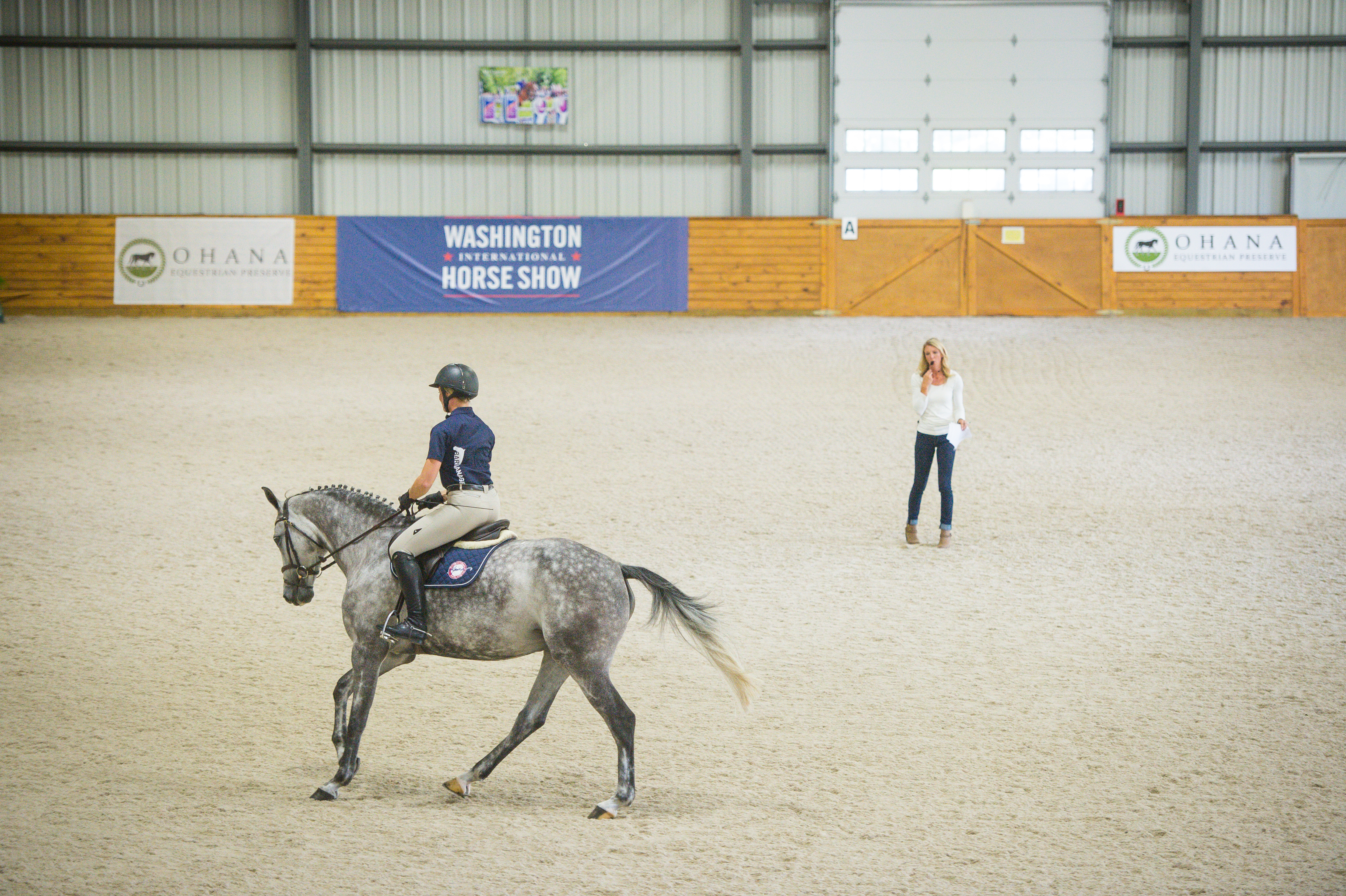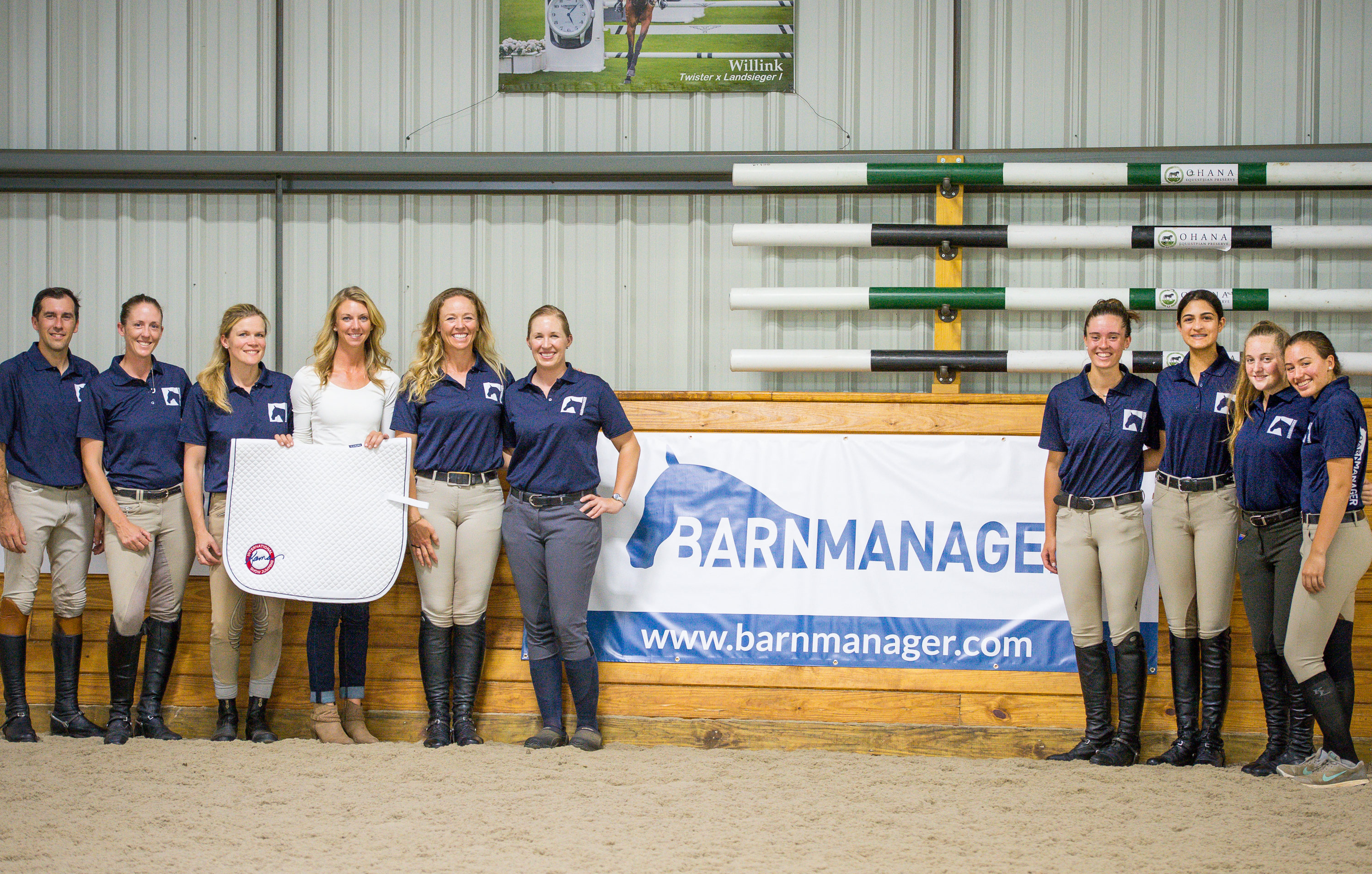
Though grand prix show jumper Kama Godek’s indoor is usually set with jumps, there wasn’t a fence in sight for the clinic with dressage rider Laura Graves. Instead, the Olympic bronze medalist and World Equestrian Games’ double silver medalist helped a group of jumper riders hone in on their dressage basics, showing that no matter the discipline, the fundamentals of correct riding ring true from horse to horse and from saddle to saddle.
Graves shared her wealth of dressage knowledge during a “Dressage for Jumping” clinic held last summer in Aldie, Virginia, courtesy of the Washington International Horse Show and BarnManager.com. Kama Godek LLC’s team won the clinic as a prize for best video during Barn Night at the 2017 WIHS.
See also: Jumper Riders Focus on Dressage Fundamentals with Laura Graves
Responsiveness, straightness and steady contact were the training pillars that Graves illustrated with various exercises and visualizations. She summed up her role to the eight clinic riders this way: “When I meet people who have had their horses for a long time, I say, ‘Somewhere in your 10- or 11-year relationship, you guys have written a contract. It’s like a prenuptial. You say, OK, you do this and I’ll do that and you don’t buck me off, run away with me or be naughty. And I won’t do x, y or z.’ I come in and help you rewrite that contract a little bit. Mediation is a big part of my job.”
How Hard Are You Working?
At the start of each lesson, Graves asked the rider, “On a scale of 1 to 10, how hard are you working—10 being that you’re working so hard you’re going to pass out from the exertion, and a 1 being that you could sing a song while trotting.” Adding that she was looking for a 2 or 3 at most on the scale, Graves explained that when she first picks up a trot, she is working at a 1. Ideally, the less she works, the more responsive her horse is.
Beginner rider Piper Tyrell began the day on a longe line at the trot. Graves emphasized that whether a rider is at Tyrell’s level or the grand prix, her threshold for responsiveness always starts in the same place: a 1. For her, a 1 is not even touching the horse’s sides with your legs. She explained, “If your leg is away from the horse’s side, the pressure of the air coming toward his side as you begin to close your leg to ask for forward movement should be enough to speed him up again. When the horse slows down, you make the correction for responsiveness.”
Another component of her responsiveness training pillar is how she rates her horse’s effort. When a horse gives his all, it’s a 10 effort, but no horse can maintain a 10 all the time. Nor does she want that. In her ideal scenario, the rider is working at a 2, and her horse has the ability to give a 10 when she asks for it.
Too often, Graves sees the opposite happen: a rider making too much of an effort. She explained, “If I’m working at an 8 and my horse is giving me a 5, my ability to make that 5 a 10 doesn’t exist.” In contrast, she said, “If I, as the rider, am working at a 1 and getting a 6 from my horse, now I have room to move up. Ask yourself, ‘How hard am I working?’”
See also: Laura Graves – How to Create a Self-Going Horse
Therefore, “as much as necessary, as little as possible” was a phrase that Graves repeated throughout the day. “As little as possible” translated to: The leg should not work to maintain the gait. Leg aids should be necessary only to cue transitions. Once you’re in a gait, it’s your horse’s job to maintain it without nagging aids from you. Responsiveness should be a state of mind, rather than a reaction.
That brought Graves to her next point: “We cannot touch the mouth until the horse is making enough energy that it’s safe to touch him in the mouth.” There is no point in asking for connection until responsiveness from the leg has been achieved.

Contain the Energy
For a dressage horse trained to Grand Prix, being responsive might mean cantering in place, Graves pointed out, until the rider applies a new hand, seat or leg aid asking for a transition to another gait or movement. Making that energy with the legs is the rider’s first job and then that energy can be contained through connection.
It’s a lot like a faucet, she explained. “Connection is something you have to build up. When I turn on my kitchen faucet, where does the water go? Right down the drain. What do you have to do in order to collect the water? You either have to plug that drain or put a cup under that faucet to catch the water—it has to have a boundary. And if we don’t give that horse’s energy a perimeter, nothing can ever get full. You’re losing every drop of water.”
Graves asked rider Abby Grabowski to think of the boundaries of the leg and hand as she warmed up her 8-year-old gelding Lemoncello, who carried himself with a high neck and slightly inverted frame. She explained that these characteristics resulted from a lack of throughness: energy flowing through the horse from the hindquarters over the topline to the bit.
Every rider is looking for a feeling of throughness, whether you are in a jump saddle or a dressage saddle. Energy that translates to a horse being in front of the leg is just one element of throughness. That is followed by straightness. Straightness is not just about getting a straight line to a fence. It is plugging the “drain” to prevent the “water” (energy) from escaping.
While Grabowski was riding on a circle at the canter, Graves asked her to pick up a shorter rein to create a contact that was pushing, not pulling back. By thinking of pushing the contact forward while not allowing any slack in the reins, Grabowski rode through from her seat and leg aids, and Lemoncello stayed straighter with this consistent contact, which helped him to maintain better energy.
Embrace Your Mistakes
Small hesitations open the door for mistakes. For Grabowski, the hesitation was as minor as slightly softening her contact when her horse straightened. Graves emphasized the importance of recognizing and allowing mistakes. Mistakes aren’t bad if you acknowledge them, she said, because correcting them makes for a straighter, more correct horse.
“Don’t cover up his faults for me,” she said. “It is in these miscommunications where the learning happens.” The small mistakes are opportunities to learn, a point that she stressed with all the riders.
Speaking of “mistakes,” Graves asked riders to commit a true sin of the jumper world: to look down to check and see how straight their horses’ necks were. Looking down at the neck put the task of straightness front and center, and most of the riders found that they habitually overbent their horses to the inside. Every rider was asked to put his or her horse in a straighter frame through consistent contact with closed fingers. Those closed fingers acted as the “cup” holding the “water” (i.e., energy) from going “down the drain.”
In giving Lemoncello a perimeter through her hands, Grabowski was able to contain his energy and ended her ride in a straighter, more correct frame.
Rev the Engine
When it came to Stefan Parker’s 11-year-old Belgian Warmblood gelding Handyman B, the focus was on engaging his mind. Handyman tends to get quick and slightly spooky. Although he began the day on the quiet side, Graves explained how strengthening his flatwork could solve the issue.
How does a rider engage a horse’s mind is a question she was used to answering. As she pointed out, a dressage horse works in an “empty sandbox” every day. Dressage riders are constantly seeking to turn their horses’ brains on, to turn them on to their job.
Working forward and back in the canter while using his outside rein to improve straightness without allowing Handyman to lean forward in the hand gave Parker the feeling that his horse was quicker in his footfalls. The change in energy within the gait quickly had the gelding paying attention to his rider.
Graves likened this new level of constant energy to a continuously running engine. “What we want to start creating in these horses is an engine that is always running, where we don’t shift gears until we want to,” she explained. “It’s like revving your RPMs and waiting a moment before you shift up into that higher gear. But if you don’t have that energy in the lower gear, you might stall when you go to send them forward.”
With the RPMs established, Graves sent Parker and his horse into a half-pass down the centerline in canter. She focused in on Handyman’s tendency to hold his neck crooked and fishtail his hind end inward. By continuing his focus on using the outside rein, Parker successfully kept his horse straight to maintain the energy.

Deliberate Intent
No one makes it to the levels Graves has risen to in her own riding career without the hyper-awareness of one’s own effectiveness. She defined this as deliberate intent. While watching Casey Osborne and her off-the-track Thoroughbred gelding Heir Apparent prepare to pick up a trot after a rest period, Graves reminded the audience that success begins with intent.
“Whenever I’m on a horse, I have a plan,” she said. “I know I’m going to touch him with my leg now. If he’s perfect, I’m going to praise him. But I know exactly what I’m after, so I know what’s perfect. If I touch him, I’m also prepared for him not to be perfect. I have a plan that’s very deliberate every time.”
Sometimes, when you spend so much time on the back of a horse, she continued, you end up doing things out of habit, not really with any deliberate intent. You have to be careful that your leg doesn’t get working “just because.” When you touch him, it should mean something. Otherwise, you’ve told him that it doesn’t mean anything at all.
The accountability that Graves demands through deliberate intent of the aids strengthened the principles of responsiveness that she began the day emphasizing.

Post-Ride Tally
Graves also gave the riders something to visualize when she shared how she assesses every ride, whether she’s in the saddle or someone else is. “At the end of my ride, there is always a tally of the number of steps I’ve taken,” she explained. “It’s like balancing my checkbook: I’m either contributing to my training with effective aids and positive steps [in green] or I’m making a deduction by making mistakes [in red].
“Ask yourself with every step, ‘Am I contributing to my training or making a withdrawal?’ And if at the end of the ride, you’ve made more red steps—or withdrawals—than deposits, then you probably should have just left him in the stall for the day.”
At the end of the clinic, each rider went away with a positive balance in his or her checkbook thanks to time spent with Graves. The footfalls that their jumpers took under her detail-oriented eye translated to meaningful contributions in green.
This article was originally published in the Winter 2018 issue of Practical Horseman.










